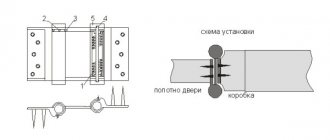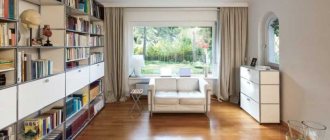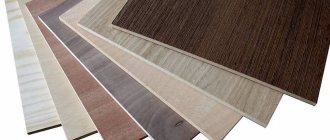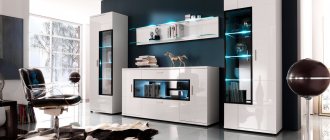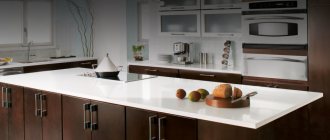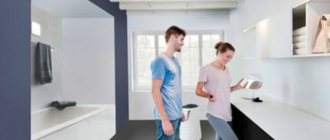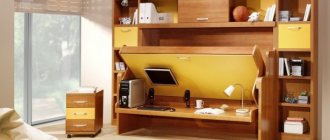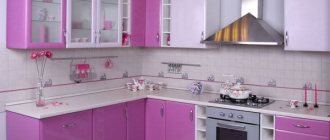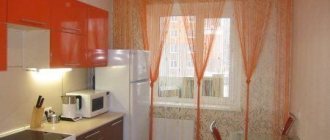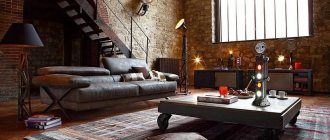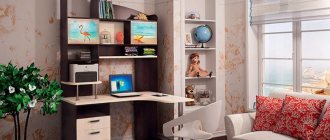The kitchen set is one of the main parts of the kitchen space. It attracts the main attention as an interior element and requires free space in the room. Therefore, you should approach the choice of kitchen furniture with special care.
Modular kitchen furniture is one of the most popular options. It will fit equally harmoniously into both spacious and small rooms. This kitchen consists of separate modules that can be rearranged as desired.
How to choose the best set for your interior and what advantages modular options have - read on.
What is a modular kitchen?
A modular kitchen can be called a construction kit for adults. Typically, a manufacturing company produces several construction blocks within one collection. It is best to consider this concept with an example. Ikea was one of the first on the market to start producing modular kitchens, so in honor of respect, let's take it as an example, namely its Knoxhult series. It is available in several colors, consider gray - it’s in the photo.
Like any kitchen cabinets, modular ones can also be divided into upper and lower.
There are three types of wall cabinets:
- single;
- double;
- single narrow for hood.
And there are three floor cabinets:
- narrow, consisting entirely of drawers (40 cm wide);
- cabinet with doors, drawer and space for embedding a stove (width 180 cm);
- wardrobe with drawer and two doors (width 120 cm).
A modular kitchen is a new solution on the market, in which the buyer independently creates his own kitchen from blocks: this is what distinguishes it from a conventional built-in kitchen set.
They can be arranged in different ways: you can buy several floor cabinets with a width of 40 centimeters and be satisfied with only them. Such a designer makes the imagination work.
What is a kitchen module
Almost all consumers and store sellers know about the kitchen module, but some ordinary people sometimes wonder what exactly this type of furniture is and what characteristic features it has.
To put it in a more understandable language, kitchen modules are a kind of constructor; the buyer can choose the most optimal set for himself for the specific conditions and parameters of the kitchen.
The ideal ratio of quality and cost is a brief description of kitchen modules, which become an excellent solution for furnishing the room most frequently visited by household members. Each manufacturer of kitchen furniture uses a certain step in their work: 5-20 cm, which allows you to better navigate the line of finished products.
Compact kitchen from modules
Pros and cons of buying a ready-made kitchen
Of course, such a new phenomenon immediately has supporters and opponents. The latter cannot come to terms with the fact that they don’t have to wait for a kitchen for several weeks, as before, but assemble it themselves from blocks. To understand how to feel about such a new piece of furniture, it’s worth understanding all the advantages and disadvantages of the product.
Advantages
Block kitchens are quickly gaining popularity, due to the large number of advantages of such a solution:
- a design project is not needed, since all modules are standard. The buyer himself selects the necessary elements and combines them at his own request. On the websites of retail stores there are often design programs where it is easy to select the necessary modules for a specific room;
- Collections most often contain several types of modules, among which you can always find what you need;
- suitable for both large and small kitchens;
- calculation of the cost of the kitchen becomes absolutely transparent;
- you can easily update the interior;
- the ability to purchase a separate module;
- installation is so easy that you can do it yourself;
- budget cost;
- simplicity - in fact, this is a ready-made solution from which you just need to select the necessary elements;
- easy to transport;
- high functionality;
- The wait for the kitchen is reduced to a minimum - most often it is in stock in the store itself, but sometimes there is a need to wait for delivery from the warehouse.
Look how many advantages have accumulated. Modular kitchen - it's fast, cheap, easy!
Making and decorating kitchen furniture with your own hands
Flaws
Don’t forget about the disadvantages of modular kitchens, so as not to be disappointed in your decision later:
- A large kitchen is more difficult to furnish than a small one. This is due to the fact that in large rooms there are often niches or ledges for which modular kitchens are not adapted;
- At the same time, in small rooms, a modular set is not always able to use every centimeter of space as efficiently as possible, which is important in a small kitchen, for example, in a Khrushchev-era apartment;
- there is not yet a large selection of design solutions for modular kitchens on the market, and most often only inexpensive materials are used;
- Since the set is not a single whole, when installing individual modules, gaps are possible - especially if we are not talking about a flat floor.
A special feature of modular kitchens is that if you suddenly get tired of one design, it can be disassembled and reassembled again, but in a different way. Sometimes you will need to buy several new parts, but in this regard, such a kitchen really resembles a construction set that can be assembled in different ways.
Who is it ideal for?
Not everyone likes to play with construction sets. But there are situations when a modular kitchen is the ideal solution:
- cost is most important;
- Need a kitchen for a rented apartment;
- Need a kitchen for a short period of time;
- I don’t want to do design work or it’s not interesting (a new kitchen is great!).
If the housewife does not fit any description, this does not mean that she will not like the modular kitchen. In any case, this new trend is worth taking a closer look at.
Popular manufacturers
There are many competitive manufacturers of modular kits of economy and premium class on the market.
The list contains the most popular of them :
- "Harmony". A company that produces furniture made of solid wood in a classic style.
- "CALL". Belarusian headsets, among which you can find a wide variety of options.
- "Maria". The furniture is made in Russia, but parts are ordered in Italy.
- "Ikea". A world-famous Swedish company producing Scandinavian-style furniture.
- “Zetta.” An Italian company that produces premium furniture at reasonable prices.
It can be useful:
Renewal, restoration and finishing of kitchen units
How to paint a kitchen set yourself
Components
The number and types of modules differ not only between different companies, but also in different series of the same company. For this reason, finding the perfect lockers can be quite difficult. But in the end, you will get a kitchen that best meets the needs of the housewife - cooking with this is a joy.
Wall cabinets most often come in the following types:
- with drying - they are placed directly above the sink;
- tableware (rarely found among modular ones) - with a glazed facade, behind which a beautiful service can be seen;
- open - without door. Perfect for a country or Provence style kitchen;
- straight, blind - the most ordinary cabinet with the usual door.
It is worth noting that this difference is only in appearance. They can also vary in size. This also applies to the lower level headset. The most commonly presented modules here are:
- under the sink - a necessary thing in every kitchen;
- with shelves - most often they are wide and designed for storing large utensils (pans and pots);
- with drawers - a very practical module, where there is more effective space compared to the usual option with shelves;
- combined - universal modules with both shelves and drawers;
- with a niche for built-in equipment - you should select based on the availability, type and size of the equipment itself;
- pencil case - a tall narrow cabinet.
One series does not necessarily contain all of the above modules. The manufacturer may have only two upper and three lower ones. When choosing, you should proceed from your needs: if there is no built-in equipment, then you don’t need a cabinet for it.
Difference from classic headsets
Modular and cabinet furniture is assembled from modules, but in the second case there is no possibility to change the configuration or layout of the finished wall.
In the case of a classic kitchen, the customer receives a strictly defined set of cabinets, decorated in the decor specified by the manufacturer. For example, a standard set of a cabinet table, a sink cabinet, wall cabinets and a pencil case cannot be expanded with an additional module with drawers or reduced by removing the pencil case.
In addition, you will not be able to change the decoration of the facade if you prefer a set with glass doors, or a similar wall only with milling or patina. In this case, you can only rely on the choice of the direction of swinging the doors. And the price of such a kitchen is initially calculated for the entire fixed set of modules.
Kitchen – White Vegas
If we are talking about modular kitchens, which were previously made exclusively to order, then you assemble the kit yourself, separately ordering the necessary modules of the required functionality (drawers, shelves, niches), material (MDF, chipboard, acrylic) and design (white, black , gray, colored, matte, glossy). This can be done with the assistance of a stylist or on your own, creating a unique set of optimal size and design.
And another important advantage of the modular design is the ability to order a monolithic countertop made of wood or artificial stone, which is not possible with a standard set. This service comes at an additional cost, but the end result is worth it.
Standard module sizes
Dimensions may vary among different companies. The record holder here is Ikea with its 180 cm in the lower tier and 120 cm in the upper. Usually these values are much more modest, and the essence is this: one cabinet - one module.
Hence the standard module width:
- 45 cm,
- 50 cm;
- 60 cm;
- 75 cm;
- 80 cm.
This dispersion is due to the fact that different companies have different views on kitchen units, and they cannot come to a common decision.
It is best to first measure the existing kitchen that needs a new set, and then draw a rough plan yourself. Then, according to this plan, it will be much easier to select the necessary modules, because household appliances such as a refrigerator, stove, hood, dishwasher or washing machine, and so on will already be taken into account.
The only thing that almost all manufacturers agreed on was the height of the lower tier. In modular kitchens it reaches 85 cm, taking into account the base (10 cm) and countertop. This is a comfortable height for people of average height (160–175 cm); others should think about trimming the base or additional legs.
Types of modular cabinets
If you decide to install a modular kitchen, you need to know that they come in different types. There are differences in the type of layout, type of opening or type of installation.
But, it must be honestly noted, these factors very rarely become decisive when choosing a block kitchen. First of all, they look at the appearance, content and cost.
Layout
Most often, the modular kitchen itself does not imply any specific layout. But with its help you can create all of the following options:
- linear - the most common option for arranging furniture, the essence of which is that all cabinets are placed on only one wall. This layout will suit any room. Most often there are both wall and floor cabinets. The ease of arrangement leaves plenty of room for a varied arrangement of modules and decor. Another small advantage is that the fewer cabinets, the lower the cost;
- parallel - with this layout, furniture is placed on two opposite walls. There is a lot of storage space, so you can often see a refusal to use wall cabinets. This layout greatly affects the geometry of the room - visually it becomes narrow, so the dining area is moved to another room;
- corner - another standard layout option that is suitable for any kitchen. As the name implies, cabinets are placed on both sides of one corner, that is, on adjacent walls. This layout is considered one of the best because it creates an ideal work triangle;
- U-shaped — arranging furniture in a U shape is suitable for spacious rooms. Cabinets can stand along three or two walls. In the latter case, instead of cabinets, a bar counter is usually installed, which at the same time zones the space. The dining area is most often removed from the kitchen, but sometimes it is located near the fourth wall;
- island - a very beautiful and multifunctional furniture layout option, in which several floor cabinets are placed in the center of the kitchen, forming an island. But modular kitchens are considered budget-friendly, so it’s very difficult to find options for an island here.
The advantage of modular kitchens is that if the housewife initially wanted a corner kitchen, but then realized that a linear one was enough for her, this is very easy to fix: just remove the necessary module.
This will not work with any bespoke kitchen, because it is made in one piece. It’s a little more difficult to make a corner kitchen out of a linear kitchen—you’ll have to buy the missing blocks.
By opening type
Here we will only talk about corner cabinets. A used corner in the kitchen is always a plus because it creates a lot of storage space. They also usually move the sink here, creating a large work area. For ease of use of the corner area, two types of modules are made, which differ in opening:
- two separate cabinets - two separate doors opening in different directions. This option is not the most convenient, since not all storage space is easily accessible, but it is more economical;
- one corner cabinet - this module has only one door. It can be folded like a book, so there is more access to the interior space. This option is more expensive.
If the kitchen is small, then it is better to pay extra for comfort. If you have enough storage space, you can put things that are rarely used in a corner.
By installation type
It is worth noting that modular kitchens come in different types of installation. This affects the form in which the buyer will receive the kitchen “at the checkout,” or most likely from the warehouse. Option two:
- glued - the buyer receives them already in the form of ready-made boxes. All that remains is to screw the door and handle to it. And, of course, hang and place all the boxes in their places;
- prefabricated - this is exactly the method that Ikea practices with its furniture. The buyer receives a flat box with all the necessary boards, fasteners, instructions and even some tools. After this, there are two ways - do it yourself or hire a assembler. In fact, there is rarely anything complicated in such instructions. Sometimes during assembly you can even do without power tools, but hanging the upper tier can be difficult due to the weight of the cabinets.
MDF and chipboard are soft materials that require virtually no physical strength to assemble. All that is necessary is to strictly follow the instructions without unnecessary thoughts like “This part is unnecessary” or “This bolt will not play a role,” which is why kit kitchens are often installed independently.
Materials for the manufacture of cases and facades
Modular kitchens are made from materials that meet the price-quality requirement. That is, it is very difficult to find super-expensive options, but you should not expect that such a kitchen will last 50 years.
Locker body
There is a very small choice here - chipboard or MDF.
| MDF | MFD boards serve as a base on which almost any coating can be applied: · acrylic; · film; · veneer; · even glass and metal. The main positive feature of the MDF panel is its environmental friendliness, because it is produced by strong pressing of wood shavings. And the variability of the top covering allows you to create furniture to suit any style. It is considered a material resistant to humidity and temperature changes. |
| Chipboard | Chipboard is a cheaper and more dangerous analogue of MDF. Chipboard is also made from wood chips, but with the use of chemicals that can be harmful to health. It is for this reason that chipboard should always be purchased in large stores or trusted places where quality is monitored. The top of the panel is covered with film and protective varnish, but even this does not guarantee protection from moisture and steam. When exposed to water elements, it often swells and collapses. |
If you have a choice between MDF and chipboard, it is better to overpay a little for quality - such a kitchen will please you for much longer.
Facing
| Plastic | Plastic kitchens are now very popular, because the color palette is practically unlimited, which means that every housewife will find an option to her liking. In addition, plastic is cheap and practical - it is resistant to scratches and moisture, and is also easy to clean. |
| Frame | The most versatile and unusual option. Module doors are made of frames into which various panels can be inserted, for example, glass, plastic or chipboard. This allows you to quickly update the kitchen interior if necessary or desired. But there is also a disadvantage of frame cladding - the panels must be selected carefully, as gaps may form. |
| Acrylic | It is considered a denser and more durable material than plastic, but in other properties they are very similar. Acrylic costs 2 or more times more than plastic. |
| Laminating film | Lamination is the process of applying special paper impregnated with a composition that protects the surface from moisture, scratches, damage and maintains a presentable appearance. One of the most popular ways of cladding the facade of an economy class kitchen. |
| PVC or polypropylene film | The cladding process is similar to lamination, but in this version the film has a plastic base, which ensures maximum protective characteristics. In addition, it looks so beautiful in appearance that it competes even with natural materials. |
| Veneer | Veneer is a very thin sheet of wood that is glued to the facade to give it the appearance of solid wood. Even a specialist will not always be able to distinguish veneer from solid wood, but you will have to pay for such beauty - this is the most expensive type of finishing. |
Style and design
The appearance and materials of modular kitchens quite limit housewives and designers, because not every style can be matched, for example, with plastic cabinets. For this reason, it is worth preparing in advance by examining the basic design options for modular kitchens.
The beauty of the kitchen is important, because the whole family will gather and spend time there. But you shouldn’t sacrifice practicality for the sake of beauty, because this is where the housewife spends most of her time, surrounded by high humidity and temperature. This is in addition to the fact that it is necessary to maintain cleanliness in such difficult conditions.
So, the main design directions of modular kitchens are:
- classic or neoclassical. Although a classic interior and a modular kitchen at first glance are not compatible at all, this is not so. Modern technologies almost perfectly imitate the texture and texture of wood, and if you choose a natural shade, then it is practically indistinguishable from solid wood. The main thing is to hide all modern technology behind the facades;
- Art Nouveau is a bold style that combines geometry and smoothness, complex textures and contrast. Here, household appliances do not interfere with the overall picture, so they can calmly stand in their place. Plastic or acrylic plain facades are perfect;
- loft or fusion - these styles love to combine incongruous things, so having a modular kitchen won’t hurt. The main thing is to add some retro elements, bright accents and roughness like brickwork to modern textures;
- High-tech is a direction in which convenience and functionality come first. The latest technologies are used here, and every square centimeter should be useful. Gloss is welcome, so you can often find an abundance of metal and glass in a high-tech kitchen;
- country, Provence, chalet - here the situation is similar to the classics. If you choose a set made to look like wood, then a modular kitchen can take root in rustic styles. In this case, you can abandon the doors on the upper set and place a beautiful ceramic service there. Sometimes they do away with the door in the lower tier, covering it with a curtain;
- Scandinavian - to create the atmosphere of Scandinavian cuisine, you should take a closer look at the light modules made to look like birch. The surface can be glossy or matte. The facades are solid or glazed. Otherwise, you should stick to minimalism.
When choosing a style for your kitchen, you need to focus primarily on yourself - your lifestyle, hobbies and character. You should not run after fashion trends, because they become outdated too quickly - and there is a high chance of being disappointed in your choice.
Interesting modular kitchen designs
Modular kitchens come in a wide variety of designs. There are bright and pastel colors, matte and glossy finishes.
Most Popular Modular Wardrobe Designs :
- White kitchen modules are suitable furniture for many interior styles. In a matte form, they will look harmonious in classic, Scandinavian and romantic styles. Glossy headsets are suitable for ultra-modern designs. They look especially advantageous in small kitchens.
- Gray. This option looks extraordinary. It looks original in modern, loft, minimalism and hi-tech styles.
- A combination of bright colors and black. For example, black bottom and yellow top or black bottom and white top. Such designs are suitable for modern styles.
- Wood with natural texture. This is a win-win option that looks expensive and noble. Suitable for all styles except ultra-modern.
Secrets of choice
Regardless of the style and materials, you need to know a few secrets that will help you create the most comfortable kitchen that will please the hostess for a long time:
- the length of one side of the headset should not exceed 2.7 m;
- Don’t forget about the working triangle (refrigerator-sink-stove) - the smaller it is, the more convenient it is for the housewife;
- there should not be less than 90 cm between the working and dining areas;
- The dish drying cabinet should be located next to the sink - usually it is hung directly above the sink;
- if the kitchen is small, then you should abandon unnecessary decor and take a closer look at folding furniture (at least chairs);
- light colors and light fabrics will visually make the kitchen larger;
- the color scheme should depend on where the windows face - if to the north, then the tones are warm, and vice versa.
All these little secrets will help make your future headset perfect even at the planning stage.
If the repair is not done from scratch, but the owner is simply faced with the task of updating the set, then you can use the following instructions:
- Choose a countertop for the sink - size, color.
- Select corner cabinets - if necessary.
- Select modules for built-in equipment - if necessary.
- Think about end cabinets - is there a need for them?
- Fill the remaining space with simple floor cabinets.
In this case, you will have to proceed from what already exists. Or decide on more global repairs, for example, moving water supply pipes.
How to choose?
When choosing modular kitchens in Novosibirsk, you should buy exactly the model that will suit:
- size;
- functionality;
- design;
- price.
It is also worth paying attention to the quality of the furniture and the materials from which it is made.
The kitchen should be comfortable, so proper placement of items is important. The sink, refrigerator and stove should be within walking distance. You should leave at least 90 cm of free space between the dining area and the work surface. This should be taken into account when choosing furniture.
DIY assembly and installation
Many manufacturers offer assembly services for headsets purchased from them. Of course, this service costs extra money. If you want to save money, you can assemble a modular kitchen yourself - there is nothing complicated about it. The process is divided into three stages:
- Assembly of individual elements.
- Marking.
- Arrangement.
Typically, assembly begins from the edge of the headset, moving element by element to the other edge. It is better to install a hanging set on a special metal profile - this will make it smoother and more reliable: you must first secure the profile itself, and then the modules.
If the kit comes with a wall panel, then you should think about the sockets in advance, mark them and cut them out. If the apron is made of tiles, you must remember that the bottom of the wall unit should be 1–2 cm below the top tile edge.
Kitchen assembly is easy!? Part one.
How to measure the room for kitchen installation
Buying any furniture begins with measurements. But if it’s easy to determine the area for a cabinet, then to properly design a kitchen you need to take multiple measurements. We list the distances you will need to know:
- Between the walls you need to take 3 measurements: at the level of the plinth (150 mm from the floor), at the level of the countertop (850 mm) and at the line of wall cabinets (2000 mm). This is due to the fact that the walls in the apartments are uneven, and in some rooms the difference can reach 100 mm.
- Between the wall and the outer edge of the gas and water pipes.
- From floor to ceiling and to the ventilation grille.
- From the wall to the windowsill and to the window.
There will be 9 measurements in total. Knowing them will help you avoid troubles when upper cabinets block the ventilation or the frame does not fit between the wall and the edge of the window sill.
Care
Since the set is made of non-natural wood, its lifespan will be shorter than that of solid wood, so it is important to think about proper care of the furniture. The principles are:
- avoid contact with aggressive substances;
- clean with a damp cloth and a small amount of mild detergent or simple laundry soap;
- After cleaning, wipe dry, as moisture can cause swelling;
- treat furniture carefully, avoiding mechanical damage - otherwise moisture may get in there;
- Do not place hot dishes on the countertop.
These simple rules will help extend the life of modular kitchens.
Homemade modular furniture
In a homemade kitchen module you can skillfully hide all household appliances and at the same time arrange the cabinets across the area in the most optimal way. The first step is to draw a sketch of the future headset using a sheet of paper or a special computer program. Having decided on the dimensions, you can proceed to calculating the required materials.
It is much more profitable to purchase ready-made fragments, which will only need to be assembled into the desired structure. All doors, as well as the walls of the modules, are assembled independently using store-bought fittings and fasteners. It is also better to entrust the cutting of parts to professionals, because... When using a home tool, the headset may end up with a sloppy edge and an unaesthetic appearance.
Set of four wall-mounted and three floor modules
To connect all the parts, the master uses a Euro tie, which ensures the reliability of the finished set and its long service life. First, the frame is assembled, after which the rear wall of the module is fixed. Next up is the countertop.
The next step is the installation of shelves and drawers. The final step of the work is hanging the doors. It is worth noting that assembling homemade kitchen furniture is no different from similar work when purchasing a set from a factory.
What's the cost?
Several factors influence the final price:
- material - as was found out above, laminated chipboard is cheaper, but will also last less;
- equipment - the more saturated the series, the higher the cost of one module will be, and the equipment of the cabinet itself affects - a cabinet with one door is cheaper than with two;
- mechanisms - the more drawers, closers, doors with a “book”, the higher the cost will be;
- decor - they will always ask for more for glass or stained glass doors;
- the company - and pricing policy in general plays an important role.
If in custom-made headsets the price is usually per linear meter, then in this case it is better to measure in separate modules. The approximate price of the module is about three thousand rubles; it turns out that a new modular kitchen will cost 25–35 thousand.
